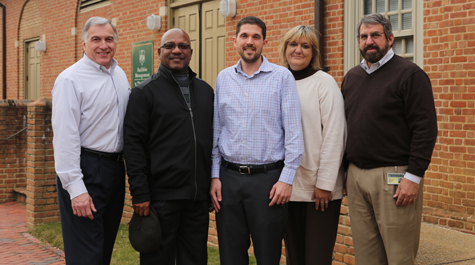Facilities Management awarded highest CIMS sustainability certification
Custodial sustainability efforts have earned William & Mary an honor that no other university in the nation has received.
In late October, ISSA, the leading trade association for the cleaning industry, awarded W&M Facilities Management the CIMS-Green Building Certification with Honors.
“We’re very proud of Facilities Management for taking the initiative and moving forward with this sustainability certification,” said Director of Sustainability Calandra Waters Lake. “It doesn’t just benefit them; it benefits the campus as a whole.”
The Cleaning Industry Management Standard (CIMS) is divided into six areas of management best practices, five core sections and one optional section: quality systems; service delivery; human resources; health, safety, and environmental stewardship; management commitment; and green building.
In order to become certified, an organization must submit written documentation outlining their adherence to the five core sections of the CIMS. The organization must demonstrate “a commitment to the delivery of environmentally preferable services that are designed to meet customer needs and expectations.” In each section, 100 percent of the mandatory elements and 60 percent of the recommended elements must be met to obtain the certification.
The sixth standard, the green building criteria, goes hand-in-hand with the Leadership in Energy and Environmental Design certification. The LEED certification proves that an organization can provide a healthy, highly efficient and cost-saving environment.
“It’s a standard of excellence that is not easily achieved. You can have a department as large as this one — 185 people, 170 buildings,” Director of Building Services Robert Morman said. “Yet, three or four people, maybe recent hires, might not have gotten the message or might not be following the process exactly the way you have it outlined, and that could negatively impact the assessment.”
An ISSA-accredited assessor spent two days ensuring that the systems and processes outlined in William & Mary’s documentation for certification were indeed being carried out across the entire campus by everyone.
With both Facilities Management administration and a staff of 165 custodians pioneering the year-long endeavor, the certification was undeniably a team effort.
“It’s an effort that speaks to the dedication and the love that the staff have for the school,” Morman said.
According to Morman, despite being the first school in the nation to receive this honor, the process is ongoing.
“Now that we’ve achieved this, we’re not satisfied,” he said. “You can’t simply say, ‘We’re using best practices today.’ You can do that, but you have to always be looking at tomorrow and developing the next generation of practices. We can’t wait around for tomorrow to catch up with us.”
Facilities Management’s current green cleaning program includes “procedures, training and shared responsibility efforts that minimize the impact of cleaning materials on the health of building occupants and protect the environment as a whole,” according to its website.
Among future initiatives, Facilities Management plans to implement a paper and plastics program over winter break, which will introduce paper towels, bath tissues and trashcan liners made from 100 percent recycled materials in restrooms across campus. The new program is part of the university’s business innovation efforts, which focus on finding cost-saving initiatives at W&M in order to reallocate funds to the institution’s highest priorities.
“Facilities Management has been at the forefront of our progress on business innovation,” said Vice President for Strategic Initiatives Henry Broaddus. “They have shown time and again there are ways to achieve cost savings and improve environmental sustainability at the same time.”
Facilities Management will post educational decals around campus to let the community know about the initiative, said Morman.
“Partnered with our certified green cleaning program, this initiative will ensure every restroom on campus is clean and healthy, and maintained using only third-party certified, environmentally preferred products, said Morman.
As a leader in the movement toward sustainability, W&M focuses on taking small steps that create a larger impression.
“I want William & Mary to have a voice in those practices,” said Morman. “So, within the state of Virginia, within our region of the country, I would like for us to be leaders in that and to become involved in a greater effort, so that the sustainability impact we have here locally can be magnified and transferred to other schools.”
According to Lake, although the certification may just be a small benefit for the campus and immediate community, the true impact is much greater.
“Since our goal is to educate students as they’re going out into the world as leaders, all these things have a ripple effect,” she said. “Their experience here is going to impact the experience of their entire lives and how they might see things in the future. So, it might be something that’s relatively small that actually makes a pretty big impact.”














